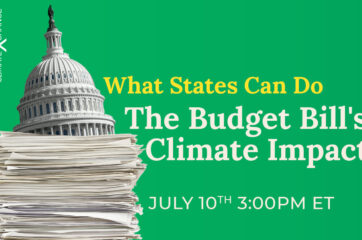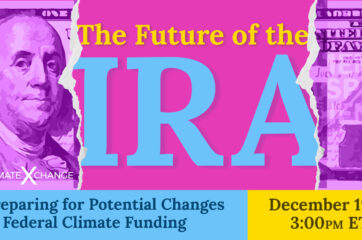Across the country, passing carbon pollution pricing policies is a challenge, despite there being widespread scientific and economic consensus on the necessity of the policy. But while the U.S. has failed to implement a federal carbon price, Canada has succeeded, and carbon pricing continues to be a hallmark of the country’s climate policy through various administrations.
On our July Deep Dive Webinar, we welcomed Barry Rabe, a professor at the University of Michigan and an expert on climate and energy politics, along with two representatives from Canadian government — Jeremy Hewitt, the Assistant Deputy Minister of B.C.’s Climate Action Secretariat, and Delegate Marie-Claude Francoeur, a senior leader in Québec’s Department of Transportation at the time of the policy’s inception and the current representative of Québec in New England.
What does carbon pricing look like at the federal level?
The idea of a carbon price has been around for many years now, with the first price beginning in the Nordic countries almost 30 years ago. At the beginning of the twenty-first century, environmentalists and economists alike saw carbon pricing as the next step forward for the global economy.
“There were great expectations many years ago that by now, the world would be governed by a seamless web of carbon pricing systems around the world linked to one another,” said Professor Rabe. So why doesn’t this exist?
According to Professor Rabe, although carbon pricing works as an economic and political policy, the political feasibility of passing it can be very difficult. Particularly, due to the fact that in most federal systems, fossil fuels make up a massive portion of the economy, and there is a history of offering federal subsidies for them. In Canada and the U.S. alike, this often manifests in provinces and states having large investments in fossil fuel production, leaving many politicians unwilling to sacrifice the profits or political influence historically gained from the fossil fuel industry.
“In Canada and the U.S., there is a long-standing history of giving preferential treatment through the tax code to production and use of fossil fuel sources,” Rabe told us, adding, “That means anything that will directly confront those uses and those preferred treatments and tax arrangements is going to be a challenge and a threat.”
There is also the challenge of frequent changes in leadership that come with democratic systems. Even if one leader agrees to implement a carbon price, it can be difficult to sustain that system when the next leader takes over. “In the United States, we can look at the Western Climate Initiative, which is now a very robust cap-and-trade system between California and Québec. But if we were talking about it 10 years ago, we would be talking about seven states and four provinces that were linked together,” Rabe told us.
In Canada, these challenges did not make passing a carbon price easy. At the federal level, the past three Canadian Prime Ministers, from a variety of political parties, all made broad climate commitments at the international level that involved placing a price on carbon pollution in their nation. However, getting every province and territory in Canada on board has been consistently difficult.
The Canadian carbon market design
In 2016, we saw progress throughout North America to create a linked carbon market, when former President Barack Obama of the U.S., former President Enrique Peña Nieto of Mexico, and Prime Minister Justin Trudeau of Canada came to an agreement to collectively reduce carbon emissions by implementing some form of carbon pricing program in each nation.
“The future really seemed quite promising, and doing that in a way that would formally coordinate a plan across these three countries, these three great energy producers, seemed likely,” said Professor Rabe. Although leadership has changed in Mexico, where a carbon price has been implemented but at a very low level, and in the U.S., where a national carbon price has yet to pass, Canada has stuck to its promise.
Trudeau’s plan places carbon pricing at the center of Canada’s national climate response — beginning at $20/ton of carbon in 2019, the plan was to increase the price until it reached $50/ton in 2022.
But how was Canada able to pull this off when both Mexico and the U.S. could not? In large part, the federal plan was built on leadership in both British Columbia and Québec, as these provinces already had robust carbon pricing mechanisms. The province of Alberta, which produces more oil in Canada than any other province, also pivoted its position in 2015 to support a carbon price, which gave the federal government excellent momentum to pass a carbon price.
“(This is) almost, if you will imagine, if a Texas governor had an epiphany, won an election, and decided to have a carbon price unilaterally in Texas. So there was this opportunity, and the federal government tried to pull that together,” described Rabe.
When implementing their pricing mechanism, the Canadian government gave all its provinces and territories two years from 2017 to either implement their own systems, or have a federal backstop program imposed upon them. This was a very attractive policy for many provinces that wanted to be more ambitious, as they had an incentive to do so. Some provinces also have a mixed program, which uses some of the federal backstop’s components, and includes some elements of their own design.
Similar to U.S. dynamics, as leadership shifts throughout the provinces after elections, support for the Canadian carbon price changes. Today, the province of Alberta actively opposes the carbon price, and unhappily uses the federal backstop program.
A key design feature of the Canadian mechanism is that revenues derived from an imposed price on carbon remain within the province or territory they are imposed in, as long as the provinces cooperate with the federal government and design their own carbon fee. But, if a province uses the federal backstop program and does not create its own price, the federal government collects the revenue themselves, and subsequently returns it in direct payments to citizens through Climate Action Incentive payments. This is another incentive for provinces and territories to implement their own price — so that they can control the revenue.
“I think that the revenue feature really gives it some flexibility, and creates a large number of systems, but everyone is still working under a somewhat similar regime,” said Rabe.
British Columbia’s leadership on carbon pollution pricing
British Columbia, Canada’s Western-most province, has had a fairly stringent carbon price since 2008. It began at $10 Canadian Dollars (CAD)/ton, and increases $5/ton every year. By 2021, the carbon price will hit a maximum of $50 CAD. This may be somewhat delayed, as the 2020 increase was pushed back due to economic downfall from COVID-19. However, the price currently lies at $40 CAD/ton. While the mechanism does not cover every economic sector at this time, it does cover 70% of British Columbia’s emissions.
“It produces a signal across the economy to reduce emissions, and is absolutely central to our climate plan. It’s my personal belief that any credible climate plan needs to include carbon pricing in some form,” added Jeremy Hewitt. However, Hewitt also acknowledges that carbon pricing must not be a stand alone policy, and should be complemented by other environmental legislation.
Although British Columbia’s carbon price began as revenue neutral, in 2018 this shifted, and the province collected about $1.5 billion CAD in its 2018/2019 cycle as it moved to a revenue positive tax. The provincial government invests revenue in two major industrial portfolios: the CleanBC Industrial Incentive Program, which helps to reduce industrial operations costs for facilities reaching certain benchmarks, and the CleanBC Industry Fund, which invests in large-scale, industrial emissions reduction projects.
Some revenue is also given back to low-income families living in British Columbia through the Climate Action Tax Credit, which gives minimum annual payments of $154.50 CAD per adult and $45.50 CAD per child to families meeting certain requirements. The government additionally invests $400 million CAD into low-income home energy efficiency retrofits.
“I will say, and I think this is incredibly important, our carbon price was actually implemented by a right-of-center Premier, and a right-of-center government,” said Hewitt, adding, “as a politician that skewed conservative, he thought, ‘What’s the best market tool? What’s the most conservative market driven-instrument to be able to reduce emissions?’ And he settled on a revenue neutral carbon tax.”
The pricing mechanism in British Columbia has already reaped massive benefits. As of this year, British Columbia has been able to source 98% of its electricity from renewables. Holding the government accountable for reaching these ambitious climate goals is essential in British Columbia, which is why the government recently passed the Climate Change Accountability Act. “It’s important to this government that we are held accountable to British Columbians, and we introduced legislation last fall with what we believe to be the most rigorous recording in North America on our progress towards (greenhouse gas emissions reduction) targets,” said Hewitt.
Québec — far ahead in the carbon pollution pricing discussion
Before British Columbia instated their carbon pricing mechanism in 2008, Québec was placing a fee on carbon pollution produced in their province in 2006. That year, Québec was worried that it would not be able to meet their Kyoto Protocol emissions reduction targets. Although a carbon price was not gaining traction at the federal level at the time, Québec wanted to ensure it could follow through with its goals, and became the first jurisdiction in North America to implement a carbon levy.
“Politicians are no different in Canada than in the United States — whenever you come up with a tax, politicians will tell you that it’s not good for the economy, and it’s not going to work. What happens then is political leadership, and we’ve been very fortunate because that’s what we’ve had in the provinces of Québec and British Columbia,” said Del. Marie-Claude Francoeur. “If your leaders are going to go that way and bring others in with them, then the rest follows.”
In 2014, the Québec mechanism expanded massively when they joined with California to implement the first price on carbon pollution to extend past national borders, called the Western Climate Initiative.
“Now the Québec and California market is the largest carbon market, and it’s the first to be designed and created by federated states, or subnationals, from different countries,” said Del. Francoeur.
Revenue from the Western Climate Initiative has enabled sustainable economic growth throughout the province. Québec invests a portion of the revenue from their price into what they call a Green Fund, which was created “to mitigate and adapt to climate change,” according to Del. Francoeur.
Much of this fund is dedicated to the Climate Change Action Plan, which has generated 43,000 jobs since its inception, and has pushed Québec to become a global leader in clean energy technologies. In total, nearly $4 billion CAD has been invested back into Québec’s economy in order to fight climate change, two-thirds of which goes directly towards improving transportation infrastructure and resilience.
“What you have to keep in mind is that half of Québec’s population is living in rural areas. When you come up with a policy like this, you have to make sure that you get buy-in from everyone in the province; you can’t only cater to big cities that have public transit, you have to be able to offer something for everyone,” said Del. Francoeur. Québec has done an excellent job of providing programs for rural areas as well, developing electric bus routes and other infrastructure outside of its cities.
Québec has big plans for the Climate Change Action Plan moving forward as well. Between 2021 and 2026, $6.2 billion CAD will be invested to reduce heat-trapping gas emissions in the province — $3.8 billion will go towards the transportation sector, electrifying vehicles and public transit; $1.3 billion CAD will be spent in the industrial sector, to help businesses decarbonize; $800 million CAD will be invested in low-polluting technologies; and $310 million CAD will reduce emissions in Québec’s buildings.
These investments are expected to spur great economic growth too, creating 10,000 jobs in five years and increasing GDP by $1.2 billion CAD by 2030. A large part of the GDP growth will be spurred by increased exports and investments in new technologies.
Like British Columbia, Québec’s price, in combination with other climate policies, has seen fantastic results — since 2003, emissions have declined by 11.8%, despite rapid population increase throughout the province. The Canadian carbon pricing model, and particularly the British Columbian and Québec mechanisms, exemplify what a successful, progressive carbon price can look like.
Moving forward in the U.S.
Despite originally agreeing to implement a nation-wide carbon pollution price beside Canada, the United States has since backed down on its promise, and carbon pricing has yet to gain serious traction at the federal level.
But that could change. If the Democratic party is able to regain control in Washington this November, it is very likely they will introduce some form of a national price on carbon, as outlined in the recent House of Representatives’ Climate Crisis Action Plan.
Canada’s history proves to us here in the U.S. that carbon pricing can be extremely beneficial, not only in reducing emissions, but also in boosting the economy and protecting low-income communities. We can certainly learn a lot from their models, and hopefully someday soon we’ll have the political will to implement similar policies.









